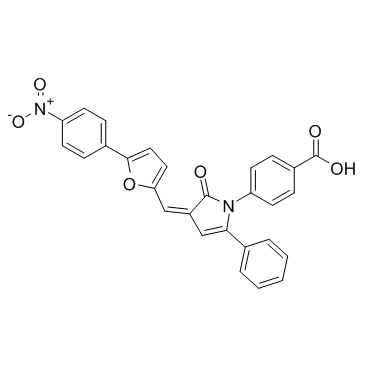328998-25-0
| Name | 4-[(3E)-3-[[5-(4-nitrophenyl)furan-2-yl]methylidene]-2-oxo-5-phenylpyrrol-1-yl]benzoic acid |
|---|---|
| Synonyms |
HMS644P11
Benzoic acid, 4-[(3E)-2,3-dihydro-3-[[5-(4-nitrophenyl)-2-furanyl]methylene]-2-oxo-5-phenyl-1H-pyrrol-1-yl]- JM2_96A HMS2595I13 4-[(3E)-3-{[5-(4-Nitrophenyl)-2-furyl]methylene}-2-oxo-5-phenyl-2,3-dihydro-1H-pyrrol-1-yl]benzoic acid 4E1RCat |
| Description | 4E1RCat is an inhibitor of cap-dependent translation, and inhibits eIF4E:eIF4GI interaction, with an IC50 an of ∼4 μM. |
|---|---|
| Related Catalog | |
| Target |
IC50: ∼4 μM (eIF4E/eIF4G)[1] |
| In Vitro | 4E1RCat is an inhibitor of eIF4E:eIF4GI interaction, with an IC50 an of ∼4 μM. 4E1RCat binding to eIF4E also interferes with eIF4G and 4E-BP binding. 4E1RCat inhibits ribosome recruitment to mRNA in a cap-dependent manner[1]. 4E1RCat blocks the capped mRNA translation, and the translation is activated by CDK1/CYCB1. Nearly all new protein synthesis in both mitosis and interphase is cap-dependent and -sensitive to 4E1RCat treatment, in HeLa and U2OS cells[2]. |
| In Vivo | 4E1RCat (15 mg/kg, i.p.) affacts chemosensitivity of Pten+/-Eμ-Myc tumors in mice. 4E1RCat (15 mg/kg, i.p.) sensitizes Pten+/-Eμ-Myc and Tsc2+/-Eμ-Myc lymphomas to the cytotoxic effects of doxorubicin (Dxr), and 4E1RCat targets translation in mice[1]. |
| Cell Assay | TSC2+/-Eμ-Myc and Eμ-Myc lymphomas are seeded in 96-well plates at 106 cells/mL in the presence of increasing concentrations of doxorubicin (Dxr) (ranging from 3.9 nM to 250 nM) and 4E1RCat (ranging from 78.13 nM to 10 000 nM) at a constant ratio of either 20:1 or 40:1. Twenty four hours later, a MTS assay is performed. To this end, Cell Proliferation Assay is added to the plates and the plates further incubated for up to 3 h, followed by measuring the OD490. Values obtained are standardized against DMSO controls[1]. |
| Animal Admin | Mice[1] One million secondary Pten+/-Eμ-Myc, Tsc2+/-Eμ-Myc, or Eμ-Myc lymphoma cells are injected into the tail vein of 6-8 week old female C57BL/6 mice. When tumors are palpable, mice are treated with rapamycin (4 mg/kg daily for 5 d), 4E1RCat (15 mg/kg daily for 5 d), or doxorubicin (once at 10 mg/kg). Compounds are administered via intraperitoneal (i.p.) injection in 5.2% PEG 400/ 5.2% Tween 80. For combination studies, rapamycin or 4E1RCat are injected i.p. daily for five consecutive days, with doxorubicin being administered once on day two. Animals are palpated daily to monitor for the onset of tumors. Tumor-free survival is defined as the time between disappearance and reappearance of tumors. Data is analyzed using the log-rank test for statistical significance presented in Kaplan-Meier format[1]. |
| References |
| Density | 1.4±0.1 g/cm3 |
|---|---|
| Boiling Point | 764.8±60.0 °C at 760 mmHg |
| Molecular Formula | C28H18N2O6 |
| Molecular Weight | 478.452 |
| Flash Point | 416.3±32.9 °C |
| Exact Mass | 478.116486 |
| PSA | 116.57000 |
| LogP | 6.28 |
| Vapour Pressure | 0.0±2.7 mmHg at 25°C |
| Index of Refraction | 1.712 |
| Storage condition | -20℃ |
